In Summary: [the truth of this story took some time to develop and determine the real facts involved. I have entered it as it came to my knowledge. One almost needs to read it in reverse order from the bottom up.]
My group of intrepid investigators (primarily TS) has uncovered documents revealing that what appeared to be two findings was actually only one!
The story proceeds as described about the dreams that led to the examination of the sugar cane field exposing up to 400 sets of remains. In the end, these were separated into three groups:
1. The largest group (about 300 sets of remains) were cremated by the Bodhibhava Foundation for making merit and brought to the cemetery in Saraburi. There is a remembrance ceremony during Qingming every year.
2. The skeletons of 106 were taken to the museum near the Bridge over the River Kwai. These are currently on display at that museum as shown in the vdo below. [also see Section 14d]
3. The remains of 35 bodies were requested by Achaan Worawut Suwanarit and deposited at the Office of the Arts Department at Prasat Muang Sing (PMS). The Director of Arts Khun Sathaporn Kwanyuen later had these bodies buried in the ground. The reason was that the storage room where the skeletons were stored had a musty smell. At present, it is not known precisely where those bodies were buried in the park since all directly involved have since retired. It is also currently unknown where the other artifacts reside.
As to the field itself, it is known to have been located on the south side of the modern city very near the large hospital, Paholpolpayujasena, at either 14.0029877 N; 99.5508442 E or 14.00104N; 99.33102 E . This is thought to be near the war-era HQ of the dreaded Kempeitai Secret Police.
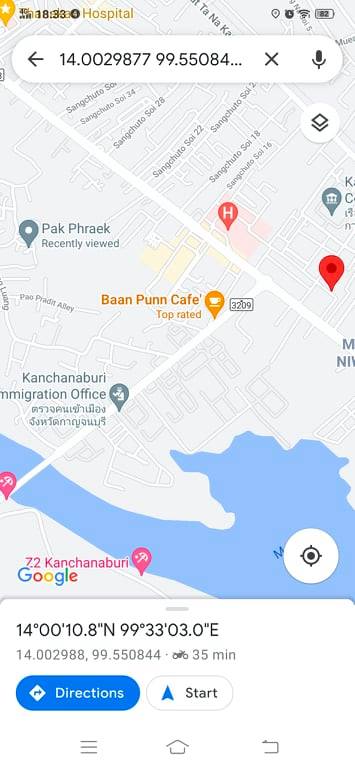
Update 2022:
A proposal for a new memorial by a colleague and fellow TBR aficionado, Thansawath Saranyathadawong:
Translated into English from his original Thai post.
An excavation in Kanchanaburi in 1990 found about 500 skeletons of Asian workers who came to build the Death Railway. This article is a little long article, but I want you to please read it to the end.
In the most oft told story of the Death Railway, we can only see images of Western (Allied) Prisoners of War (POWs), thin to the bone. Their work was hard and they were subjected to violence by Korean guards and Japanese soldiers. Many thought that the railway could only be completed because of the sweat and life of a western prisoner of war.
But in fact, there were huge numbers of Asian laborers from many nations, including India, Burma, Singaporean, Vietnam, Laos, Cambodia, Malays, Javanese, Indonesians, as well as local Thai workers. There were as many as 250,000-500,000 Asian laborers building the Death Railway of whom 30-50% died!
There are about 61,000 Allied POWs, which is actually many times less than the Asian laborers. But we also know very little about the story of the Asian laborers.
For reference, I use the New York Times as I wrote above.
Article on the World War II Cemetery in the book of Arts and Culture in February 1991 written by Khun Sathaporn Kwanyuen, an officer of the Department of Arts at the search point.
The book written by Ajarn Worawut Suwanrit [editorial note: unfortunately now deceased] titled the Great War of Asia and another set of articles and documents from Pak Phraek area, written by Somchaya Thanangku
The number of deaths of Asian laborers is estimated at 90,000-100,000, or 40% of all Asian workers because of being crowded; lack of sanitation; to say nothing of the lack of medication, insufficient food, and many diseases.
Turn around and look at the Allied POWs. The death toll was about 13,000, or 21% of all prisoners of war. The living conditions of prisoners of war were bad, such as not enough food, not enough medicine, hard labor but if you come across the story of the Asian laborers, you will know that the prisoners of war had better living conditions than Asian laborers. Prisoners of war were normally soldiers with knowledge of discipline and cleanliness; to prevent epidemics as well as in each unit was a military doctor. Therefore, these physicians are also able to advise or be able to design and modify existing ones into medical devices; including requesting to share medicines from Japan to treat the severely ill . Prisoner of war camps have better cleanliness management compared to laborer camps. Separate camps were set up for various disease patients to prevent infection from spreading.
Therefore, it is not wrong to say that the Asian labor force is the main labor in the construction of this railway line.
Let’s get into the story about the discovery of a large number of skeletons of Asian laborers at the side of Kanchanaburi City Hall in 1990. To begin with, it seems mysterious and difficult to answer. But here is how the story unfolded:
“One night, the owner of a motorcycle repair shop named Khun Sompong (a Wang Sai native) had a dream that he was standing in a sugarcane field.
There were many people in the sugarcane-free area. But the conditions of those people were all languid, starving, sick and wearing torn clothes. They looked pitiful, someone walked in and told him to come and help them to get free. In the dream, Khun Sompong recalled that there was a large stag (dead and devoid of foliage?) tree in the area as a landmark.
Khun Sompong tried to find the area of his dreams. So drove a motorcycle to search. When he arrived in front of Soi SangChuto 14, something inspired him to stop and ask the locals there. Khun Sompong asked if there were any burial grounds in this alley. The old man in front of the alley didn’t say anything, just pointed into the alley. So he drove to look and found that there was a sugar cane field and in it was a huge bare tree, as he had dreamed of. The area is located about 100 meters from the city hall wall* and about 200 meters from SangChuto Road. [*In the area of the large City Hall and near the huge hospital complex on SangChuto Rd.]
But when he found it, but Khun Sompong was still unable to do anything.
At that time, there are people from the Bodhi Bhavana Welfare Foundation [aka Bodhi Bhavana Relief Foundation or มูลนิธิโพธิภาวนาสงเคราะห์ at https://www.facebook.com/phothiphawana/ ],to contact would like to buy the land of Mr. Sompong. So his wife took this opportunity to discuss the strange things that her husband had dreamed of and the places in his dreams that he had found. The staff of the said foundation gave advice that Khun Sompong contact the landowner, Teacher Ananya Wattanayam, for permission in writing to dig on her land.
At first, Teacher Ananya denied that she had never buried anyone. But her older sister insisted that this sugar cane field used to be a burial ground for a railway worker during World War II. She related [Bg 25pg19]: “when she was about 20 years old [1945] field hospitals for sick Indians, Malayan and Singaporean workers were located where the Kanchanaburi Provincial Hall is now. Every morning the Indians dug a hole to bury the dead bodies in the evening. The bodies were simply thrown into the pit and covered with dirt. Some days, 2-3 bodies were buried; some days more than 5.” Teacher Ananya agreed to sign a permit to exhume the body without asking for any compensation for excavating the field. Another neighbor stated [Bg25pg19] that: ”I saw Japanese soldiers digging huge graves into which bodies were dumped. Some were sick but still alive.”
A tractor was loaned by Pol Lt. Gen. Chamras Mangalarat, to plow the area until the soil was ready to look for the skeletons to be dug up with a hoe and shovel.
Before starting the digging, the Bodhiphanasongkho Foundation held a ceremony for the dead. In the excavation, there will be a spirits and the medium pointed to the graves. Red flags were placed and excavations were carried out. Many people participated in this merit making ceremony.
On the 15th of Nov 1990, the first day of the exhumation hundreds of skeletons were found lying on top of each other in a hole. Also found were some a glass containers and a number of zinc-coated rice bowls.
By Nov 16, 1990, as exhumations continued, approximately 104 more skeletons were found.
After news spread, the Director-General of the Fine Arts Department came to inspect the excavation area. Seeing that this kind of digging may destroy historical evidence, he asked that they stop digging. A letter was sent to the Governor Kanchanaburi and he ordered the foundation to temporarily stop the excavation handed the project over to the Archeology Division Muang Sing Historical Park led by Khun Sathaporn Kwanyuen and with Ajarn Worawut Suwanrit, Secretary-General of Kanchanaburi Rajabhat Cultural Center [or teacher’s college in those days].
On 20 Nov 1990
The Archeology Division began digging two trenches beyond the site of the foundation’s excavation to the south, but no bodies have been found. By 23 Nov a third trench was dug near the site previously excavated by the villagers.
In this third area, about 4x5meters in size, 35 over-lapping skeletons were found; 24 facing north, 11 facing south. The skeletons were deteriorated due to the fact that it was under a sugar cane field and had trapped groundwater. Most of the skeletons were located 60-70 cm below the surface of the soil. One of those skeletons belonged to a girl under the age of 10, as she still had her baby teeth. And at the same time, a bracelet was on the left arm of this skeleton.
From the excavations of archaeologists many double burials were unearthed. There were two burials in the same pit. That is to say, after the first burial, the soil was layer about 30 cm. and then the other corpse was placed on top and then the grave was covered.
In addition, they also unearthed the belongings of the deceased like metal water cylinders. Some had a stamp written on the origin of the production as Hong Kong or Japan. Some reports say the year of manufacture is 1939. Two pieces of metal Takrud [a tube-shaped amulet or talisman] were found and a piece of rope was found in the Takrud’s string loop. The Takrud was found at the hip of the skeleton. (That person had tied the Takrud around their waist)
Some of the bodies were found with teeth inlaid with gold. Some of the bodies were found wearing dentures. Seven bodies were found to have black teeth caused by chewing betel nuts.
The archaeological evidence is consistent with the stories of the elderly that in the past this area was an Asian labor camp and witnesses had seen the digging of the graves of Asian laborers (reported to have been Tamil-Indians). It is suspected that there may still be more remains in the areas adjacent to the sugar cane field, but they had no permission to work there.
The statement is as follows:
Mrs. Urai Bosub
65 years old, Pak Phraek villagers, interviewed on November 21, 2000
“Said that at that time [1942], he was 15 years old, the Japanese came to Kanchanaburi. An Asian labor camp was built along the railway line from Ban Khao Din to Ban Bo. (presently Phahon Hospital). Asian workers had a hard life, waking up early and going to work hard with not enough food. Malaria, dysentery and cholera caused many deaths. Some children have no rice to eat, no milk to eat, and were so skinny. The deceased laborer were be buried. The bodies were tossed and piled on top of each other and sprinkled with lime to reduce bad smell because the grave would not be covered at once as so many corpses had to be disposed of. When enough corpses were added, the grave was filled.
Mr. Iam Bosub, 81 years old, interviewed on March 20, 2008.
The Japanese camp was located at Ban Bo School. As for the Indian, Javanese, Malay labor camp, at Ban Bo Hospital. Mr Iam saw that many workers fell ill. Some people are cholera. Some people have wounds all over their bodies. There were many deaths. and the bodies were buried behind the school [now the Phahon Hospital sit].
The abbot of a temple in Ban Pong [near the beginning of the TBR; 50 Kms from KAN] had seen Asian Indian laborers get off the train at Wat Don Toom and walk to Kanchanaburi. The procession was accompanied by children and women. Most of the women were the wives of male workers who left for work. Women are also housewives and cooks.
Robert Hardie, a British physician POW, said of the Asian laborers: A large number of Chinese, Malay, Indian and Tamil laborers were persuaded to build the Death Railway. By the way, Japan claims that it’s a light job and good pay. They were sent to Thailand by arriving at Ban PongThe [Wat Don Toom] from there they were herded on foot to Kanchanaburi and beyond. Asian laborers numbered in the tens of thousands and camps were set up along the railroad tracks.
We have heard of the horrors of death from the epidemic among the Asian laborers. Many were so ill that they could barely speak. Some Asian laborers died in the forest, rotting corpses were not buried. The sanitation system does not have crowded people. There were swarms of flies all over the place. Importantly, there is no medical treatment in these camps.
Muthammal Palanisamy, a former teacher in Malaysia has tried to piece together the story of the surviving Asian laborers returning to Malaysia after the war. She has gathered information from 12 Malaysian laborers and that story is being compiled and will continue to be written in a book. It is noteworthy that many Indian-Malay Asian workers say the same thing: the Japanese soldiers invited them to work on building a railway. The construction of this railway will help Japan send troops to fight against the British and this railway would help to liberate India. This is one reason why the Tamil-Indians who were sent by the British to work in Malay decided to join the construction of this railway.
When studies revealed that these were not corpses associated with prehistoric civilizations, Arts Department itself did not continue the survey and let the Bodhib-havana-songkha Foundation come to exhume the rest of the bodies from the area.
===============================
The next question is, where are those bodies now?
The information obtained is as follows:
In the Foundation’s documents, it stated that after excavating for 10 days, they had enough skeletons to fill a six-wheeled [medium sized] truck. The bodies were brought back to the foundation’s HQ in Bangkok to make merit and perform funeral rites. After cremation, the ashes were taken to a cemetery in Saraburi Province [northeast of Bangkok]. Annually. Chinese rituals are performed during Qingming [https://en.wikipedia.org/wiki/Qingming_Festival]
Before cremation, the Thai Department of Fine Arts inspected the skeletons at the Bodhibhavana Welfare Foundation in Bangkok. But little additional information was gleaned because of the skeletons were all jumbled together with others from other cemeteries.
This was the largest group of remains that were excavated and disposed of.
The second group of 106 was handed over to the Axis and Prisoners of War Museum beside the River Kwai Bridge.
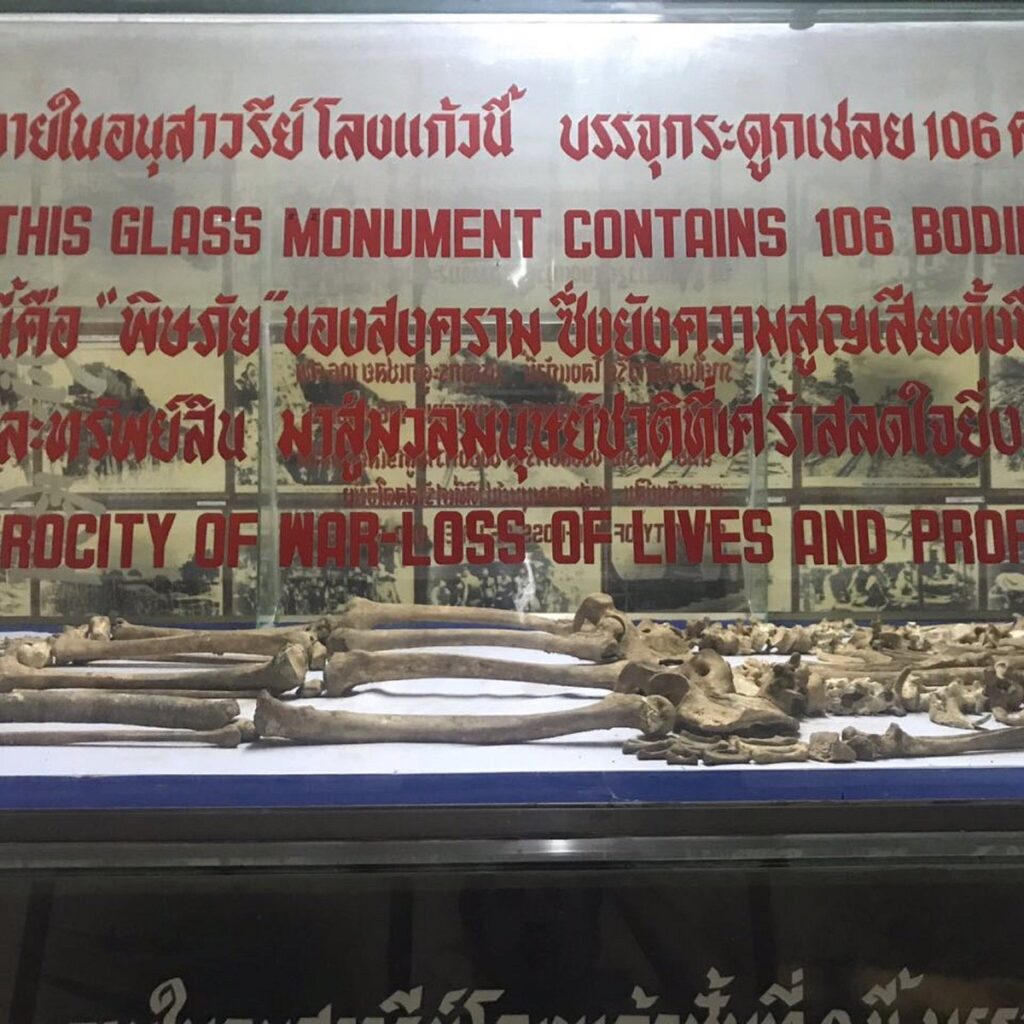
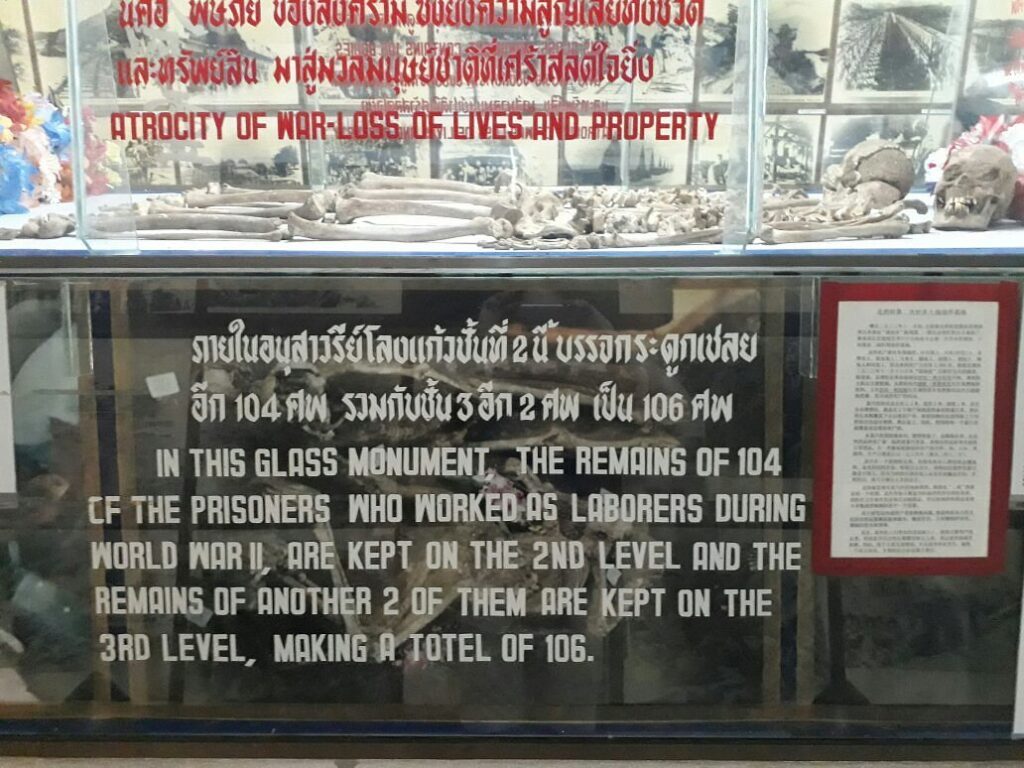
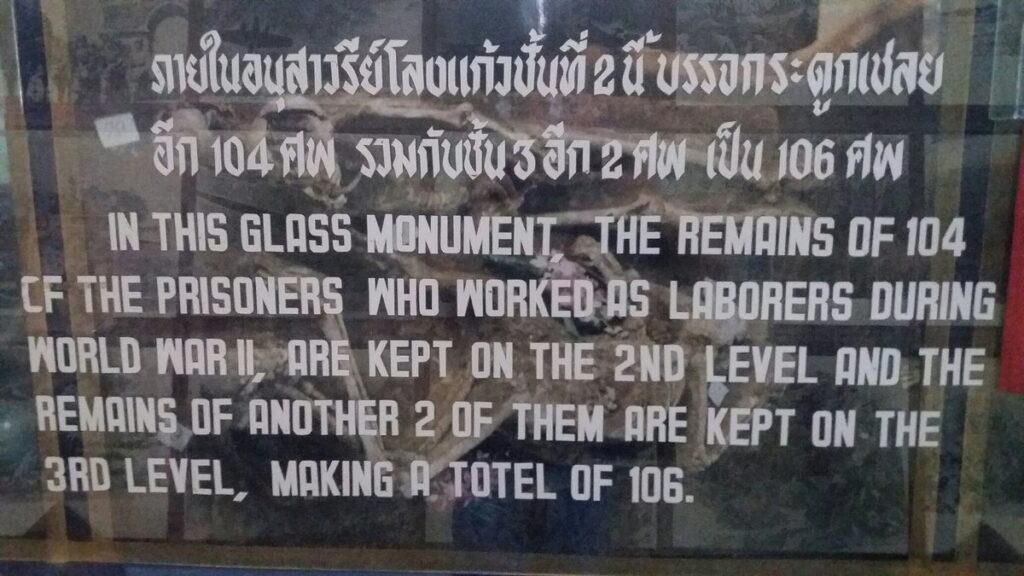
There two of these Asian laborer skeletons remain on display in a glass case. The other 104 skeletons are located in another portion of the museum.
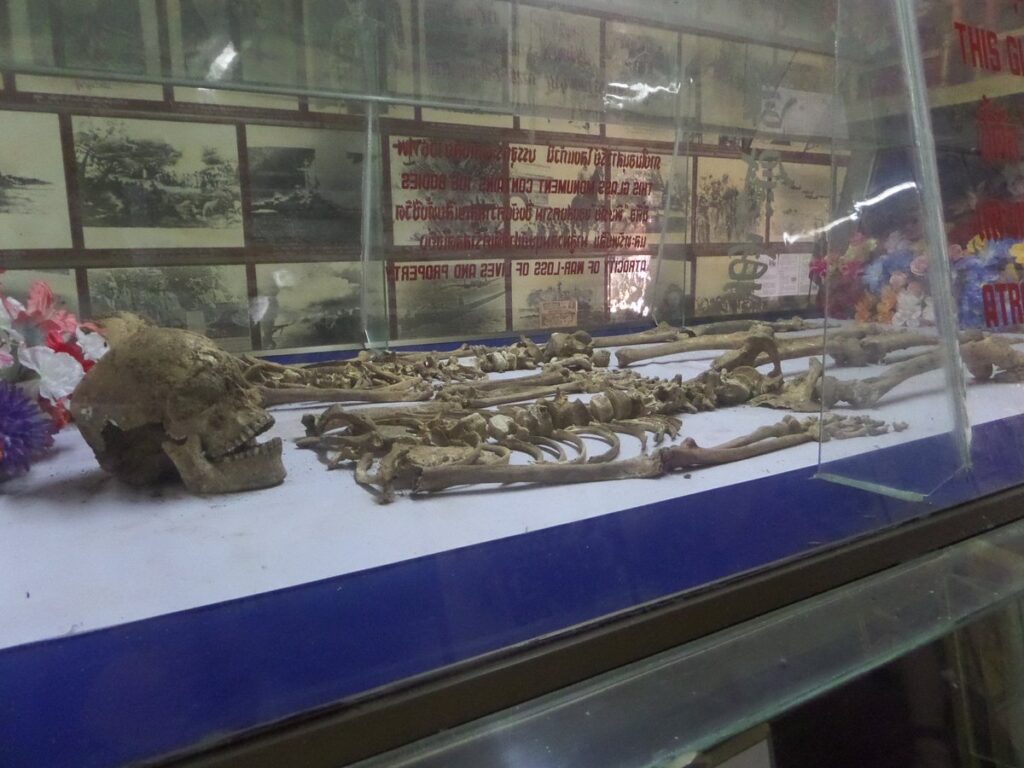
The last 33 skeletons, as written in International Herald Tribune, New York Times by Thomas Fuller, March 11, 2008:
Thomas Fuller came to Thailand to cover news about the Asian laborers who helped build the Death Railway and interviewed Ajarn Worawut Suwanarit about the Death Railway and the funeral of Asian Workers. Including interviews with people who were involved in events during World War 2 such as Mrs. Urai Bo Sap and Nai Thongyu Chalwankumphi a former Malaysian Asian laborer who lived in Thailand. (Currently deceased)
In one news article:
After many skeletons of Asian workers were excavated at Pak Phraek, Kanchanaburi, Ajarn Worawut Suwanrit requested the province to establish a memorial museum or cemetery for these workers. But did not receive any response from government agencies.
The news also states that Ajarn Worawut Suwanrit exhumed the bodies of Asian workers with his own funds and deposited 33 skeletons at the Muang Sing Historical Park for preservation.
In 2008, Ajarn Worawut Suwanrit and Thomas traveled to Muang Sing Historical Park to ask to see the skeletons that had been deposited, but received the news that those skeletons had been buried a few years earlier. The reason the skeleton was buried was due to the musty smell of the skeleton storage room and complaints from staff and visitors. So one of the staff dug a hole for 33 skeletons.
I called to the Muang Sing Historical Park, the woman who answered the call and I asked about the person named in the news to confirm that those graves were actually dug. But those who buried them were temporary workers and left soon thereafter. And now no one knows where the 33 skeletons of Asian laborers were buried, because the officers in those days were all retired, and some of them had died. But when looking back at news content in the New York Times in 2008, it added that the pit where those skeletons were buried was near the compost heap, he used the term compost heap, which no one would know today because it was many years ago. That means Thomas Fuller and Ajarn Worawut knew where the 33 bodies were buried (but Ajarn.Worawut has since passed away.)
=======================
I am not here to attack the work of any agency or person. Just take the story that came from it including the published stories, because I believe that more and more people would like to know where the skeletons that were unearthed reside today.
As per the information in many books and documents Including information from interviews with various people of Ajarn Worawut, it is believed that in the area around the City Hall, Phahon Hospital, as well as the area around Soi SaengChuto 14 and surrounding areas, there are likely to be many remains because the former was an Asian labor camp. At the present time, no one wants to dig or do anything more to learn what stories could be told.
The information on the existence of the Asian labor camp in Thailand is exactly the same as what I received from a foreign friend who said that the area of City Hall and Phahon Hospital used to be an Asian Indian labor camp (Tamil people) because there is evidence of aerial photographs during World War II.
Personally, I believe that in that area there are probably skeletons of Asian laborers left. Without causing a panic for people in the area some just want to know the history of the area there. Many, perhaps most, wish to leave the story untold. Perhaps out of fear that it might devalue their land. Some areas are tombs of Asian laborers who are still after all this time.
As I seriously explore other regions of the railway, I talk to many villagers. I have learned the story that in the past that there used to be many small camps along the Death Railway. Many skeletons have been excavated. For example, around Kui Yae or around Tham Phi Station (before reaching Khao Khad Chong) have been excavated, but this is not news. Because that area a long time ago was a remote area. Uninterested, the corpses were carried to the temple and burned to make merit. The tombs of the Asian laborers cannot compare with the tombs of the Allied POWs. The Commonwealth War Graves Commission (CWCG) Cemetery looks shady and beautiful. On the grave markers of the Allied soldiers are words of lo, pride and remembrance. But the unmarked graves s of the Asian laborers are often in the middle of the forest; in the villagers’ gardens. Some are in public areas or government offices. There is a monument at Wat Yuan [next to the CWGC Cemetery; about 2KMs west of the Hospital site] that is reported to contain over 10,000 sets of remains that were unearthed post-war as road construction and building proceeded.
The corpses had to lie in the cold ground, undiscovered and invisible. No one knows their existence. As I said above, first I dedicate this writing to the Asian laborers. So that they still exist in the perception of people today. I believe that not many people have heard of these stories. Second, I would like to dedicate this research to Ajarn Worawut Suwanrit who was a teacher I loved and respected very much, Ajarn WorawutSuwanrit, would have liked to create a museum or cemetery dedicated to these Asian laborers but was unable to push it to happen.
I would like to use this article to help signal to those involved that we should not forget these Asian laborers.
Much on the railway that Thai people use to travel from Nong Pla Duk to the Nam Tok station; that Thai people have used directly and indirectly to earn a living from tourists, was built by these Asian laborer; with the sweat, the physical force, the life and the tears of the Asian laborers.
But what we usually hear is that Allied POWs built this railway. I do not agree with the expropriation of the land of the people who live and turn it into a cemetery. But I would like to suggest that soil from the areas that used to be camps or cemeteries of Asian laborers should be collected and used to make a statue or incorporated into a memorial for them. Or will we be haunted by a mourning message from them – as was Khun Sompong. That soil is the flesh, the hair and the bones of the dead Asian laborers decomposed over time.
I said as if I could do it myself. But I can’t do it myself. I have to ask everyone to help communicate these stories and pictures of Asian laborers to follow this link:
https://www.facebook.com/110480247217381/posts/313541240244613/?sfnsn=m
I have chosen to leave the earlier portion of this section unedited as it was originally written as a question about these remains.
Part 1 Wat ThaWorn Wararam or
Wat Yuan Vietnamese name is Kan Taw Ter
[also see Section 20.5]
On 1 July 2021, I visited and spoke with Khun Nataphat Tetanown = manager / administrator of the Wat Yuan Cemetery.
He explained that this temple is over 200 yrs old and the current 11 rai of land (not including the cemetery) is but a small part of the prior holdings that once extended across what is now SangChuto Rd. The cemetery also pre-dates WW2.
He explained the meaning of the various buildings in the cemetery: [see the Gallery below; tap the pix to expand to full size]
First the obelisk located almost central in the cemetery is the burial site of as many as 10,000 sets of remains that were found just after WW2 as SangChuto Road was being widened. The area across from the Wat Yuan Cemetery (just SE of CWGC Don Rak Cemetery) was known to be the space that many of the romusha workers were consolidated into as part of the larger Kanchanaburi POW camp.
He further related that over the years there have been at least three burial ceremonies as other road building and construction projects unearthed more remains. He noted that the chamber under that obelisk is a minimum of 7m deep. He expressed his belief that although the vast majority belonged to romusha of many Asia countries, some of the remains are of foreigners = Allied POWs. [see below] There is no evidence that the Kanchanaburi camp held any Allied citizen internees.
He pointed out that to the right (SE) of the obelisk the colorful memorial is the Chinese equivalent of a spirit house for the cemetery. Off to the left, is a small Chinese-style building that serves as a chapel for annual rights performed by the family members of those buried in this cemetery. The vast majority of graves are simple Chinese family-style graves and Thai-style chedis of ordinary people.
One other grave located in front (on the same side as the inscription) is that of the Vietnamese-Thai man who contributed many of the buildings at the current temple complex. This is a simple gray granite structure that is festooned with VN-style lion statues.
Khun Nataphat himself is of Chinese heritage but he noted that the area of the city behind the CWGC Cemetery has many families of Vietnamese ancestry. Indeed as we approached the temple gate we noted 2 Vietnamese restaurants. Apparently many of the first refugees arrived from Vietnam during the reign of King Rama 2 when the temple was founded and was known as Wat Yaun (Yuan is the Thai slang for Vietnam). It was re-named Wat Thaworn by King Rama 5 who granted it royal status. Today, nothing remains of the WW2-era or older buildings.
He pointed out a framed photo hanging nearby as dating back to the post-WW2-era and depicts worker building one of the current temple buildings. I inquired about the 1990 story of the unearthing of about 400 sets of remains from a sugar on the north side of the city. He denied any knowledge of that event. [see Part 2 below]
As to Khun Nattapat’s belief that Allied POW remains are included those of the Asians, this is highly unlikely. Even with the threat of punishment for doing so, Allied Officers kept quite good records of their charges and particularly of those who perished. Not every set of remains was recovered by the immediate post-war searchers (often accompanied by those who had laid the men to rest), but the names and circumstances of the deceased are known even when their remains were not recovered. There is a mass grave at the Don Rak CWGC cemetery that contains the ashes of some 300 bodies that the IJA demanded by burned not buried when they died during the cholera outbreak. There is also a plaque at that site with the names of a few dozen Dutch POWs whose remains were not found. This combined with the area of the WW2 camp where the remains were found, all speaks against there being any Allied personnel included in these burials.
As to the belief by some that this monument is in some way related to IJA soldiers, that too, seems patently false. Although it is not impossible, there is no reason that any such remains would be present in this area. For most of the time of the TBR construction and afterward, Kanchanaburi was indeed an IJA HQ and supply base, but few if any IJA soldiers are known to have died there. The Japanese took great effort to honor their fallen comrades; seemingly some were repatriated to Japan after the war as well. We also know that a memorial was erected at Wat Don Toom in BanPong dedicated to as many as 100 IJA soldiers who died. But they are thought to have died in that area, not 50 Kms away in Kanchanaburi. We also know that the remains of the IJA soldiers killed in the BanPong Incident (see Section 20.3) were sent to Kanchanaburi for cremation under the purview of Railway HQ.
In thanks, for the information he provided I made a contribution to the temple.
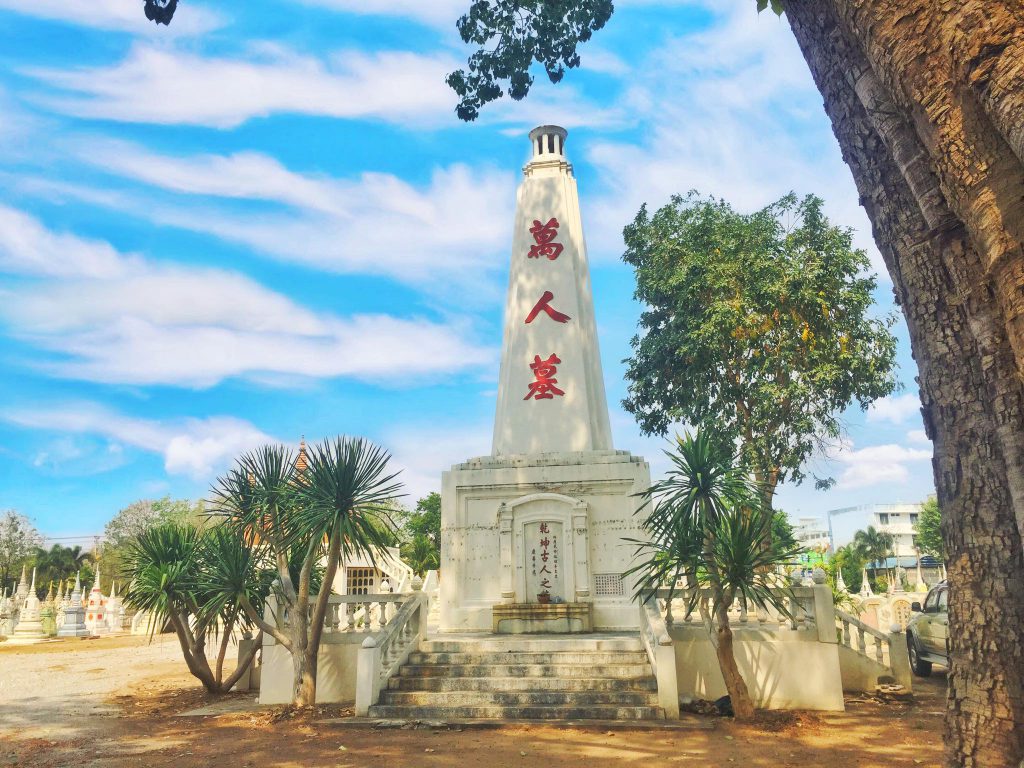
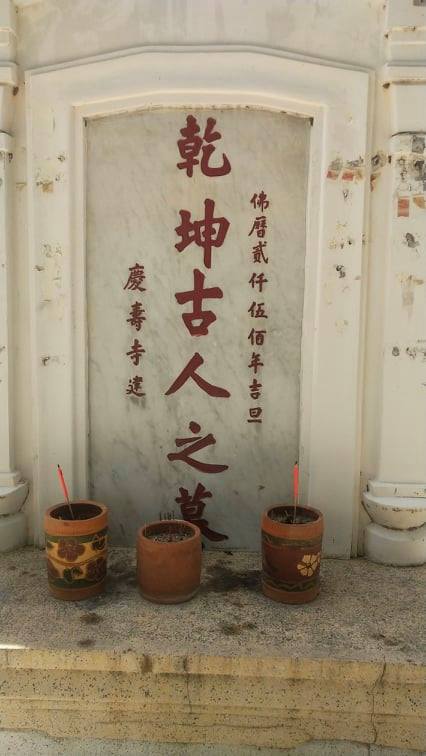
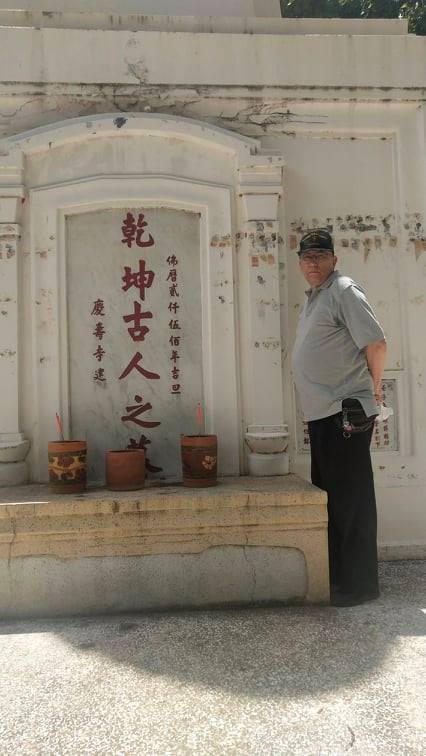
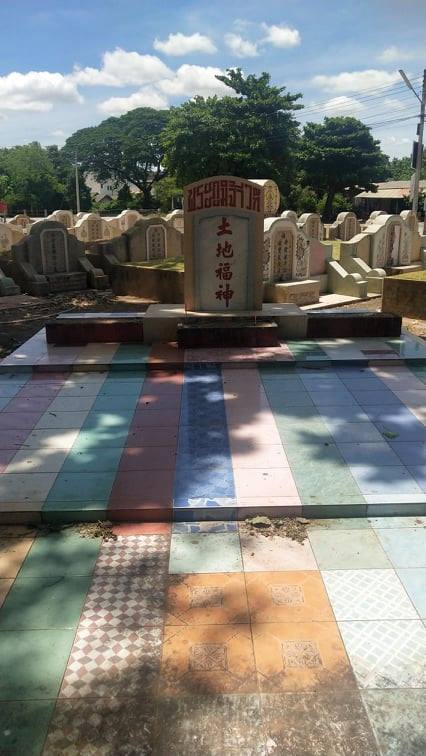
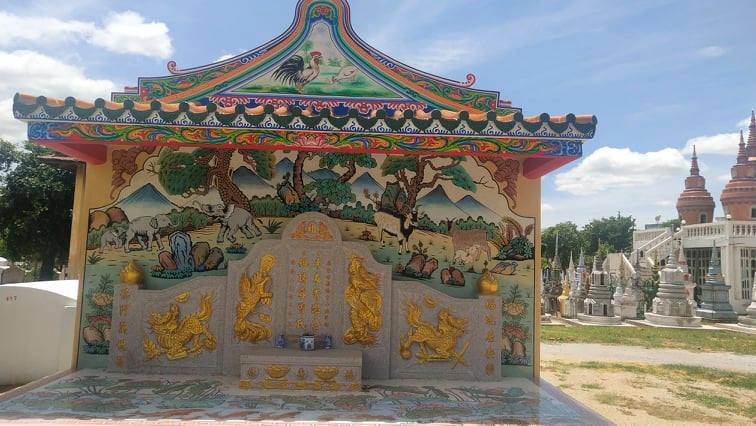
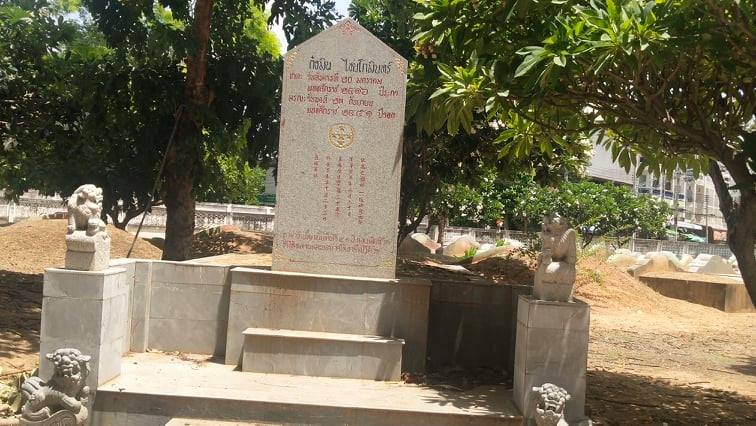
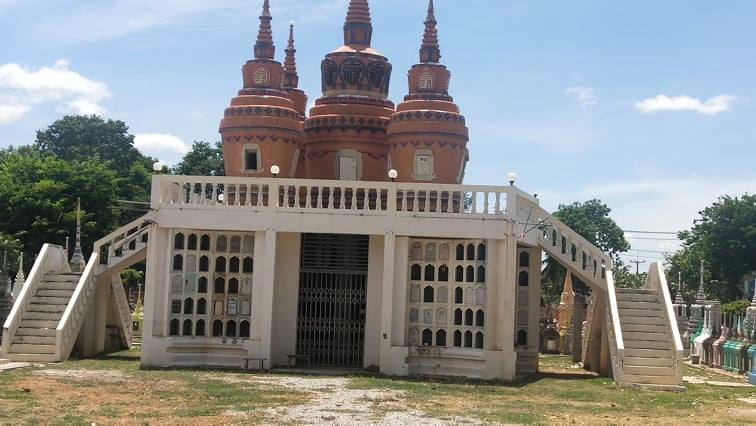
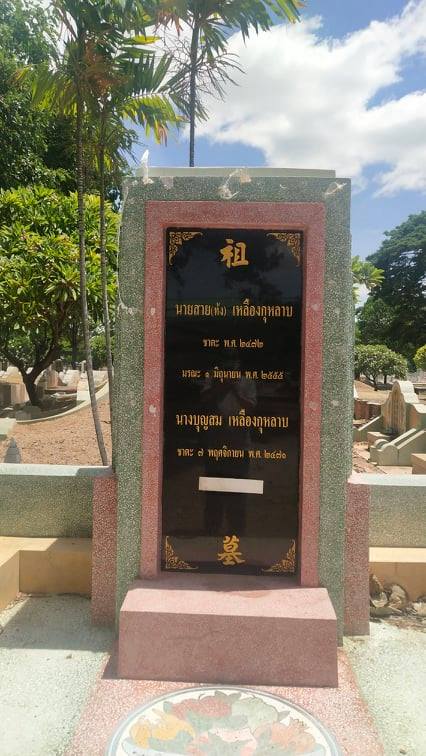
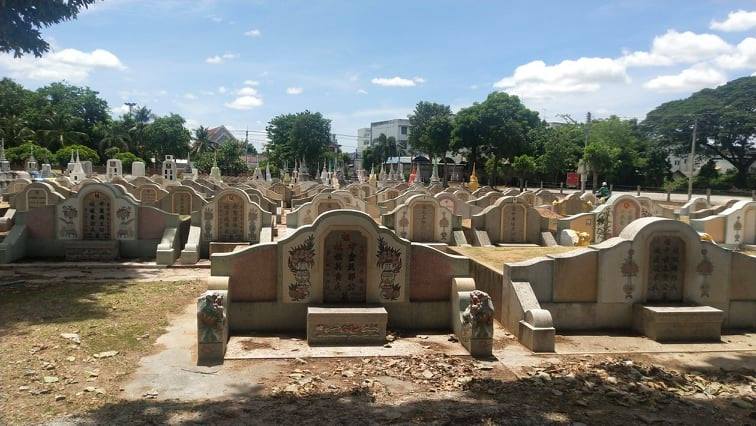
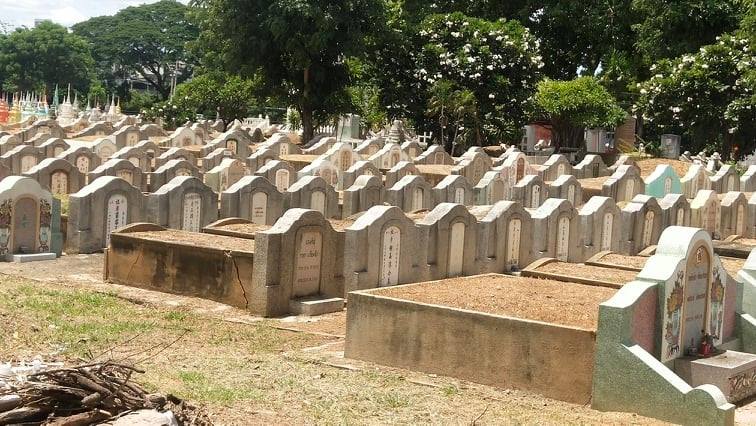
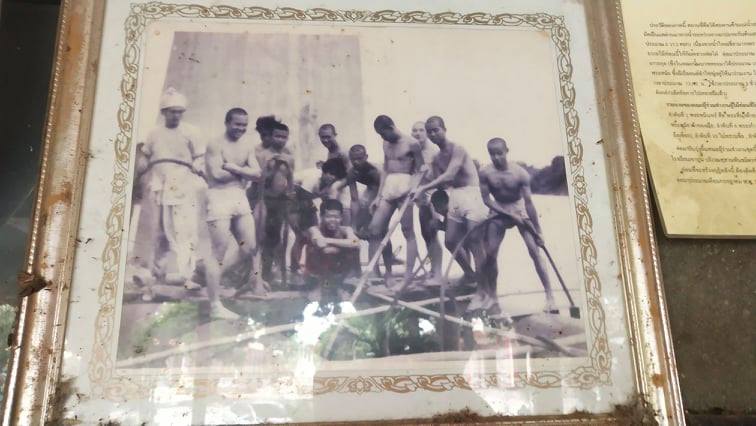
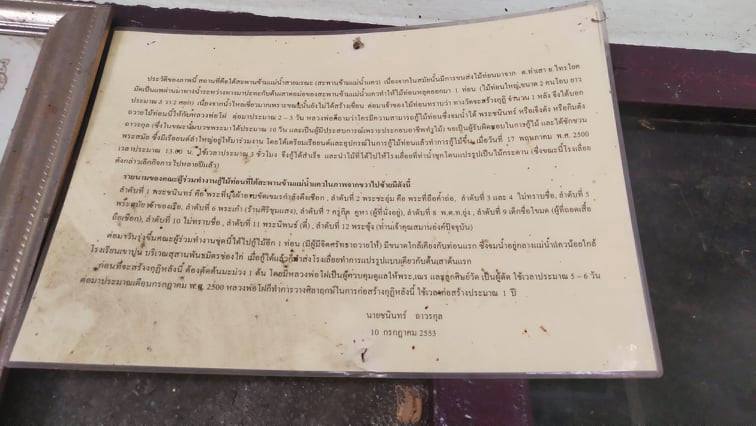
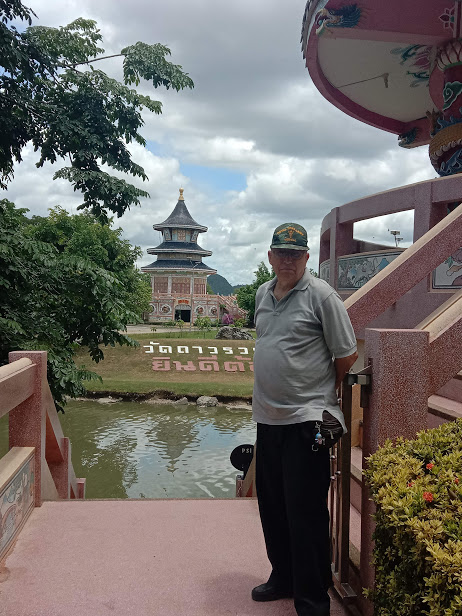
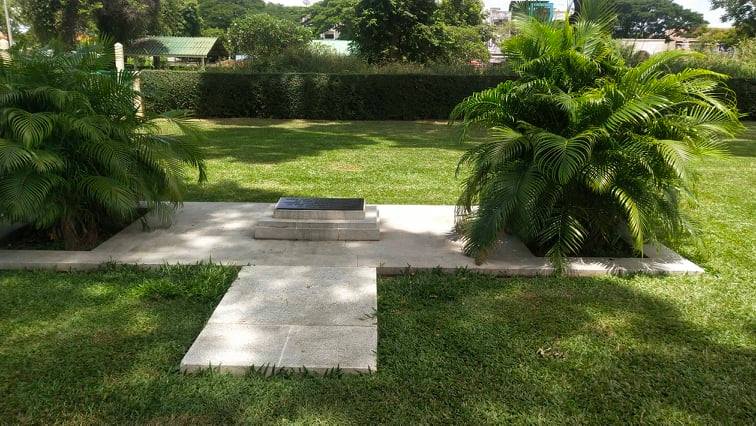
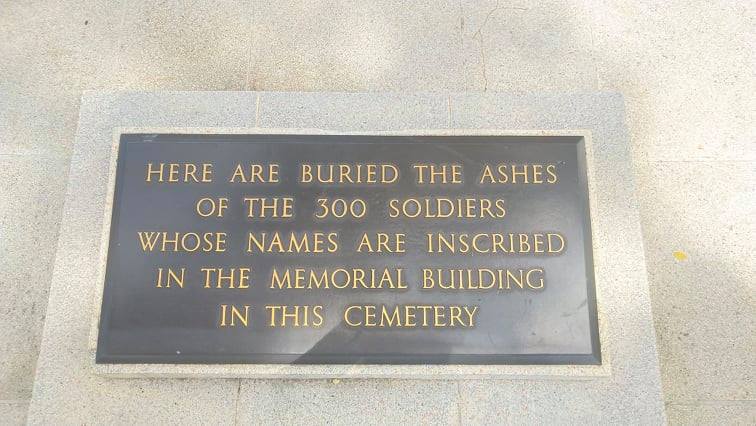
Here is an example of what can be found on the internet that just CONFUSES the story of what TRULY happened:
“I want you to know about the Unknown Soldier and Workers Memorial it is another monument related to World War 2 related to the construction of the Death Railway in Kanchanaburi. Many people must have been through this memorial for some time. Some people know where to go But there are some people who don’t know yet. This memorial is one of Kanchanaburi’s memorials related to World War II, especially in Kanchanaburi, there are many that are still important. (I’m trying to collect as many World War II-related monuments as I can research.)
This memorial is a memorial located at the cemetery of Wat Thavorn Wararam (Wat Yuan) used to collect the bones of soldiers and laborers who died in the construction of the Death Railway. This monument was built in 1957. The monument is a square pedestal like the Thaiyanusorn Monument at the River Kwai Bridge. Wat Thavorn Wararam cleared the cemetery after being abandoned for more than 30 years. This clearing of the cemetery has found the bones of prisoners of war and laborers who were conscripted to build the Death Railway. And brought to the cemetery at this Yuan temple, more than 4,500 bodies, most of them Chinese, Indians, Malays and Indonesians. This cemetery is adjacent to the Kanchanaburi Allied War Cemetery fence. (Don Rak) has an area of about 10 rai, but because there is no message telling the history of this monument Therefore, it is not widely known.
It is another forgotten monument.”
Lek Ban Tai
[Obviously, much of what is written above is incorrect. It is simply an example of the types of documents and information that can be found and then have to be verified and placed in context]
There is also a second rather confusing story that in the 1990s a former Australian POW returned to KAN in search of the graves of fellow POWs that he had helped bury. He was apparently searching for a specific tree in what had formerly been the Aerodrome area. Today, the site is best found as the area behind the Red City Market. Once again, the newspaper account is rather sparse on details, but being unable to find what he was looking for he made contact with the Australian Embassy. They, however, claimed that they had no records to indicate whether remains had been reclaimed from that area. The story did not ID his deceased mates by name so their fate remains unknown. It only adds to the mystery if any of the remains identified as romusha contained any Allied POWs as well.
I will reiterate that the POWs were extremely careful and thorough in marking the site of the thousands of burial sites along the length of the TBR. There are many existing hand-drawn maps of those burial a sites. I believe that it can be safely assumed that the vast majority of the POW remains were collected and reburied at the three CWGC cemeteries. The story is also told that the owners of the JEATH #2 museum near the bridge initially displayed skeletal remains with Australian artifacts. It took the intervention of the British EMB to convince them that those remains we not Allied POWs. That display remains but without the AUS items.
Part 2: A mass romusha grave in Kanchanaburi:
A young man was plagued by ‘bad dreams’ that seemed to lead him to a sugar cane field on the outskirts of the modern city of Kanchanaburi. He approached the owner of that newly harvested field in Oct 1990 and convinced her to have some workers dig into the earth. They soon exposed skeletal remains, dozens of them. She called on the assistance of the History and Cultural College in Nakorn Pathom and they completed the excavation of about 400 bodies. These were later determined to be ethnic Tamils. They had been almost certainly buried in 1944-45 as the Allied POWs and romusha were consolidated from up and down the TBR to the Kanchanaburi area. It is fairly well accepted that there was a romusha camp in this general area. The mass grave was perhaps a kilometer or so to the SE of the main CWGC cemetery and the site of the larger romusha camp. [BANGKOK POST 18 NOV 1990] The elder sister of the owner (then 75yo) related that she had watched daily (in 1945) as bodies were removed from the ‘hospital’ used by Tamil (Indian) and Malayan workers from the TBR. In actuality, these were little more than death houses where the sick were sent from the camp area.
In February 1991, the director of the nearby Muang Singh Historical Park published a report on the excavation in the Sinlapa Wathanatham magazine of the university. Most of the remains had been turned over to the Chinese Jin Siang Tung organization for cremation. He also states that there were likely many more remains still undiscovered since the owners of adjacent fields would not grant permission for excavations to be carried out there. He estimates that the excavated area was no more than a half an acre. All indications were that there were women and children included in these burials. One person interviewed stated that they saw some of the ‘bodies’ moving as they were being buried. This supports other claims by Allied POWs that the Japanese would order the burial or even the cremation of cholera patients before they were actually dead.
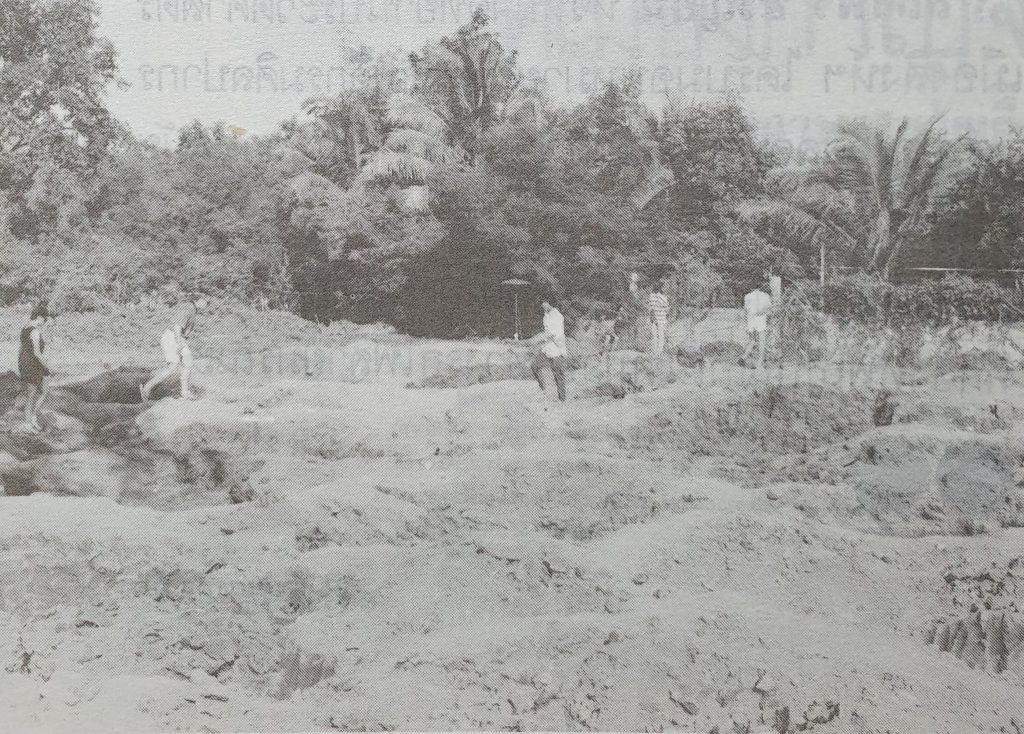
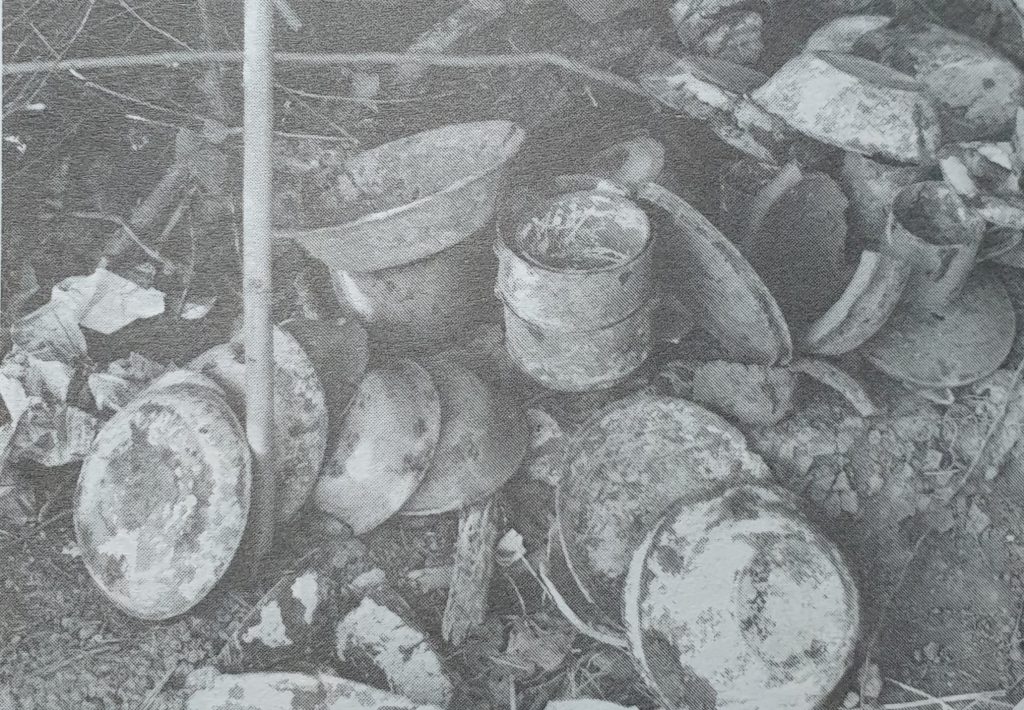
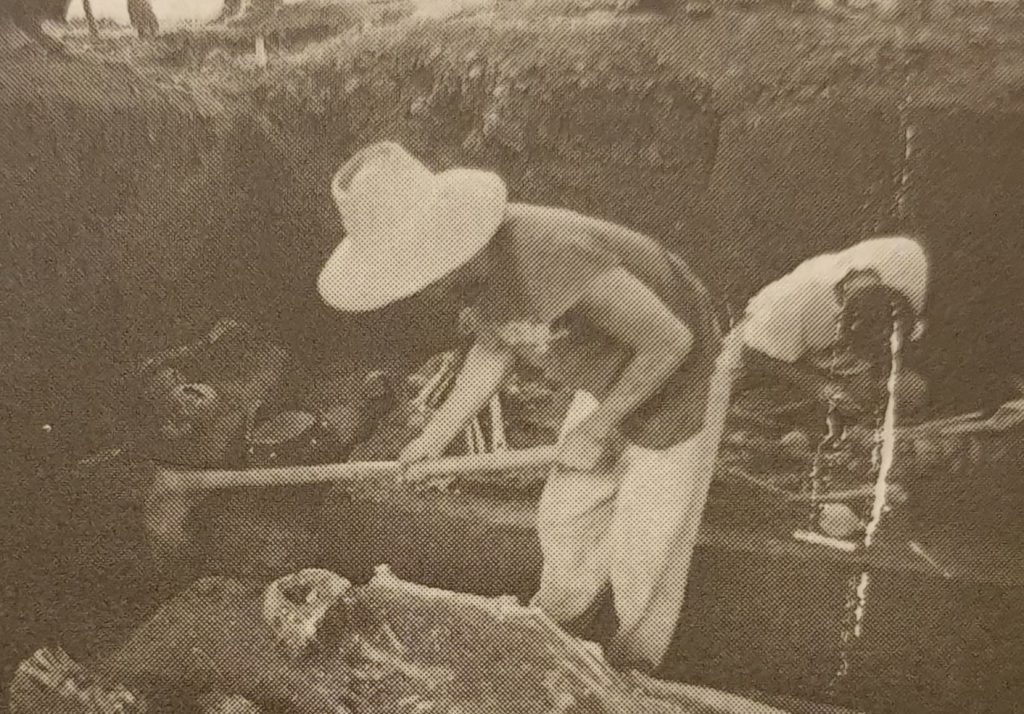
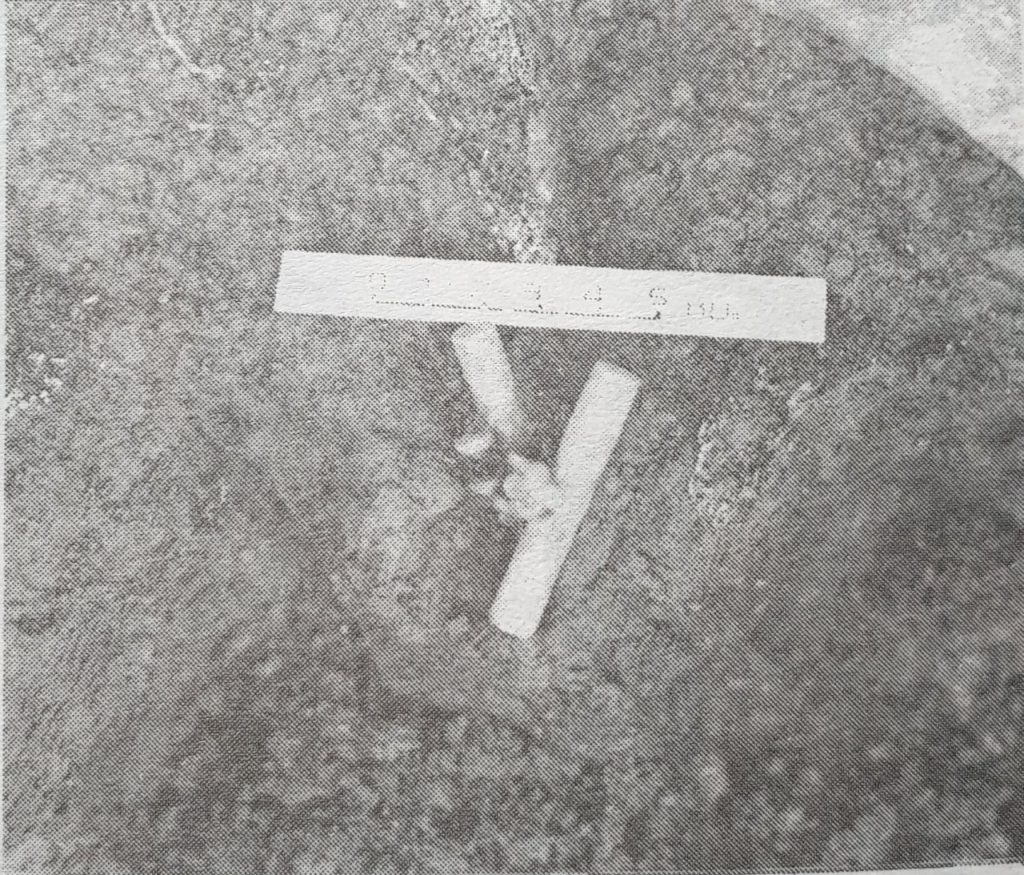
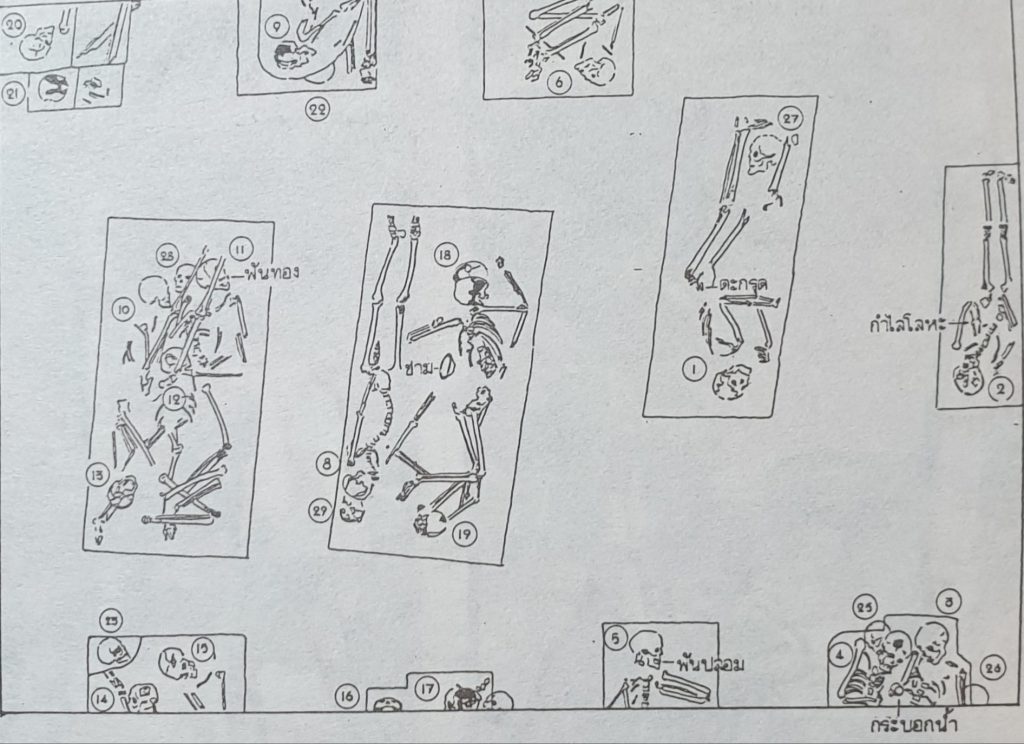
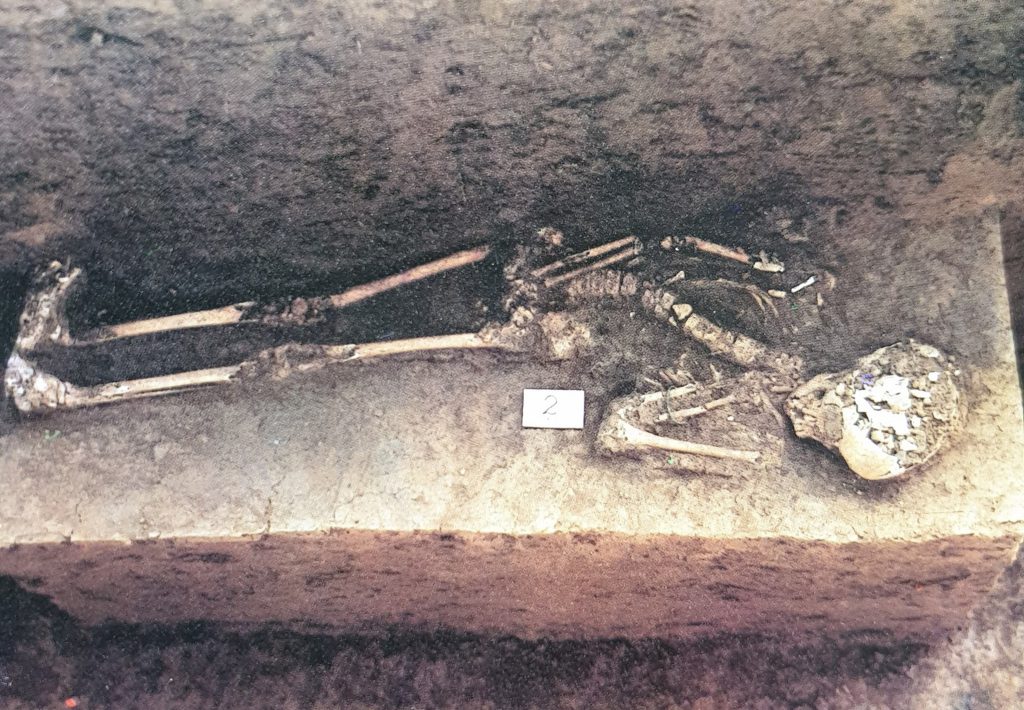
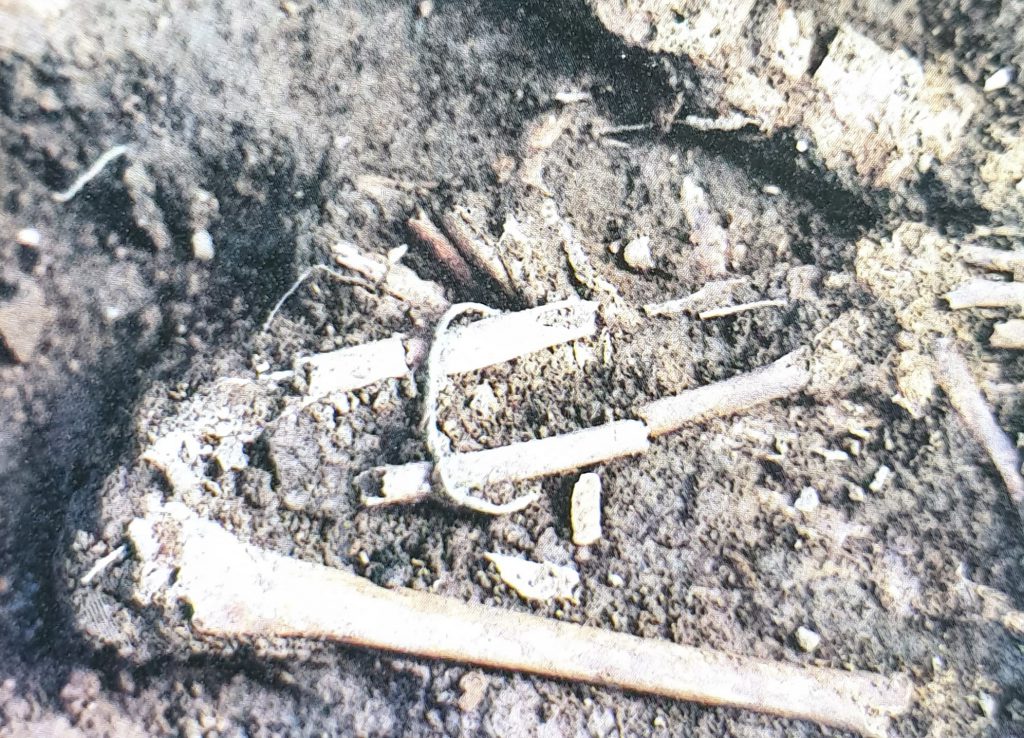
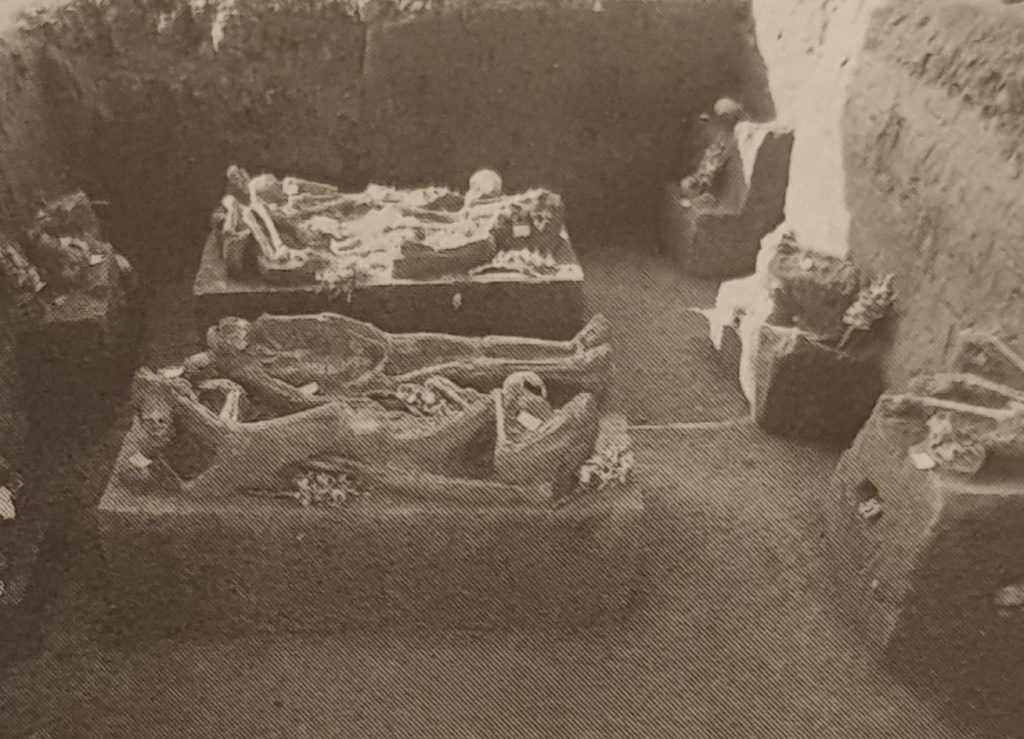
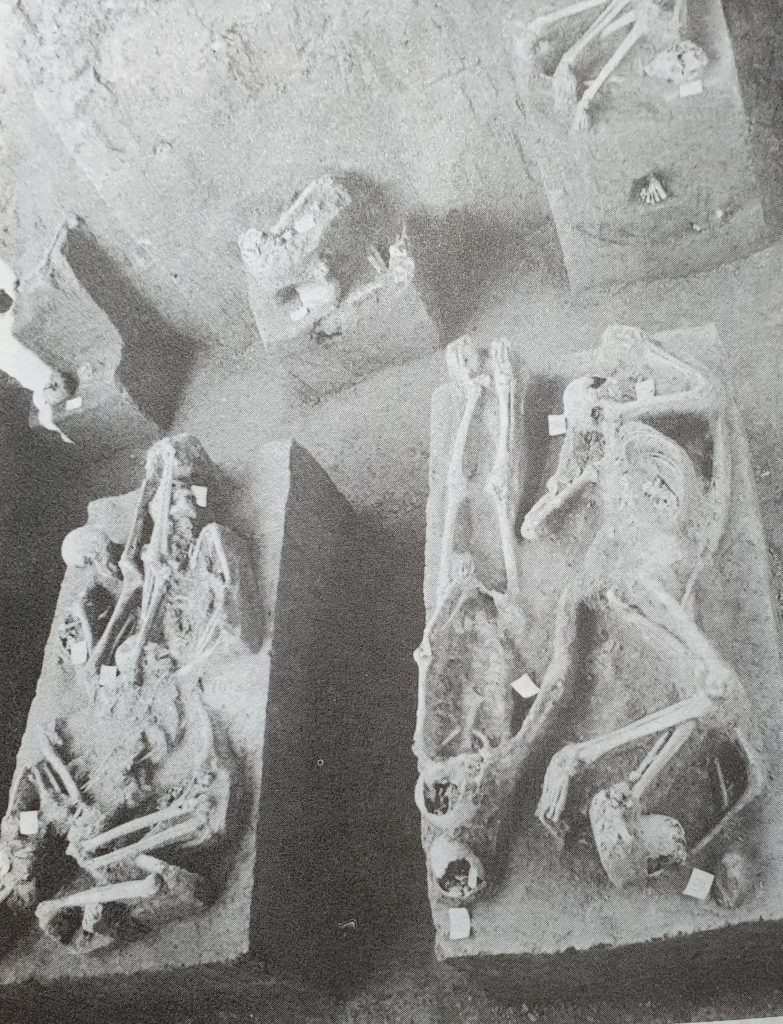
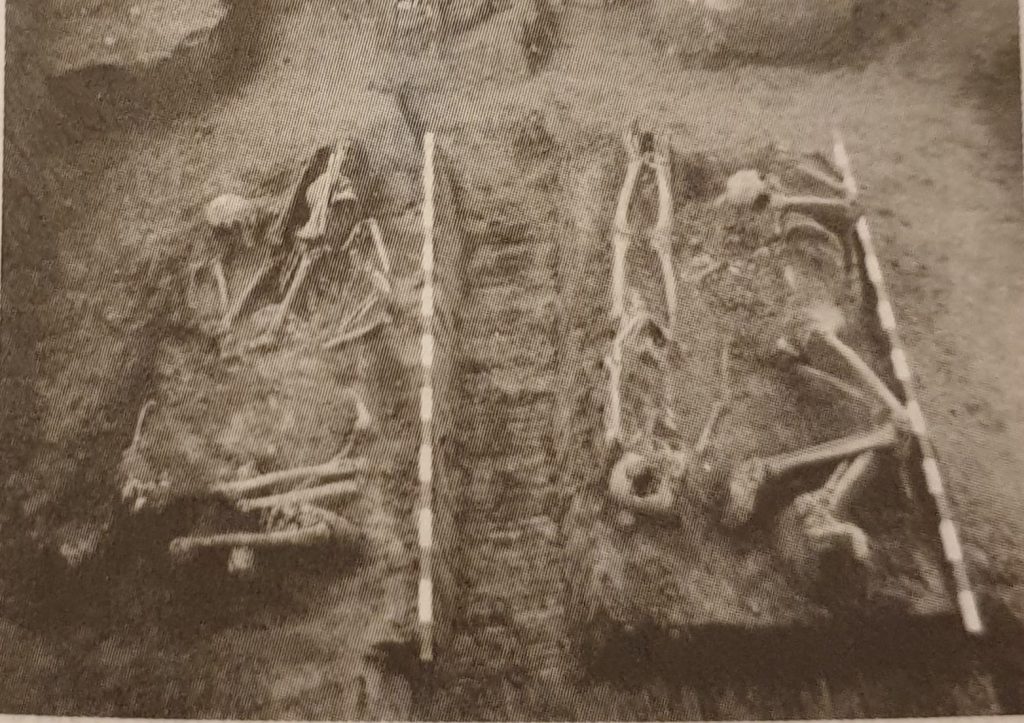
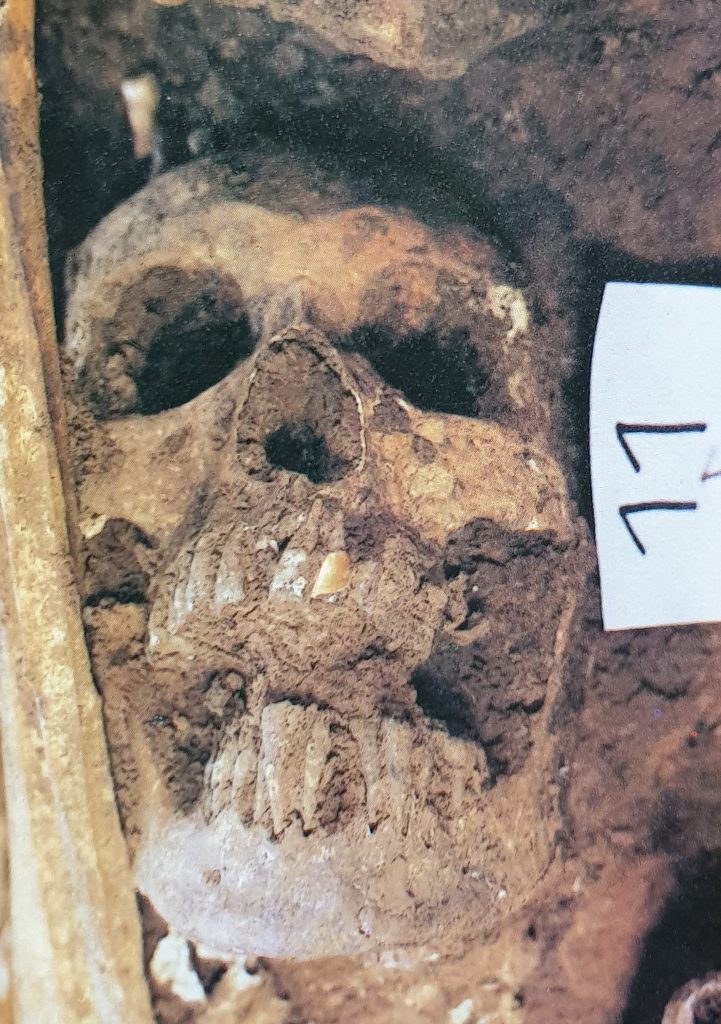
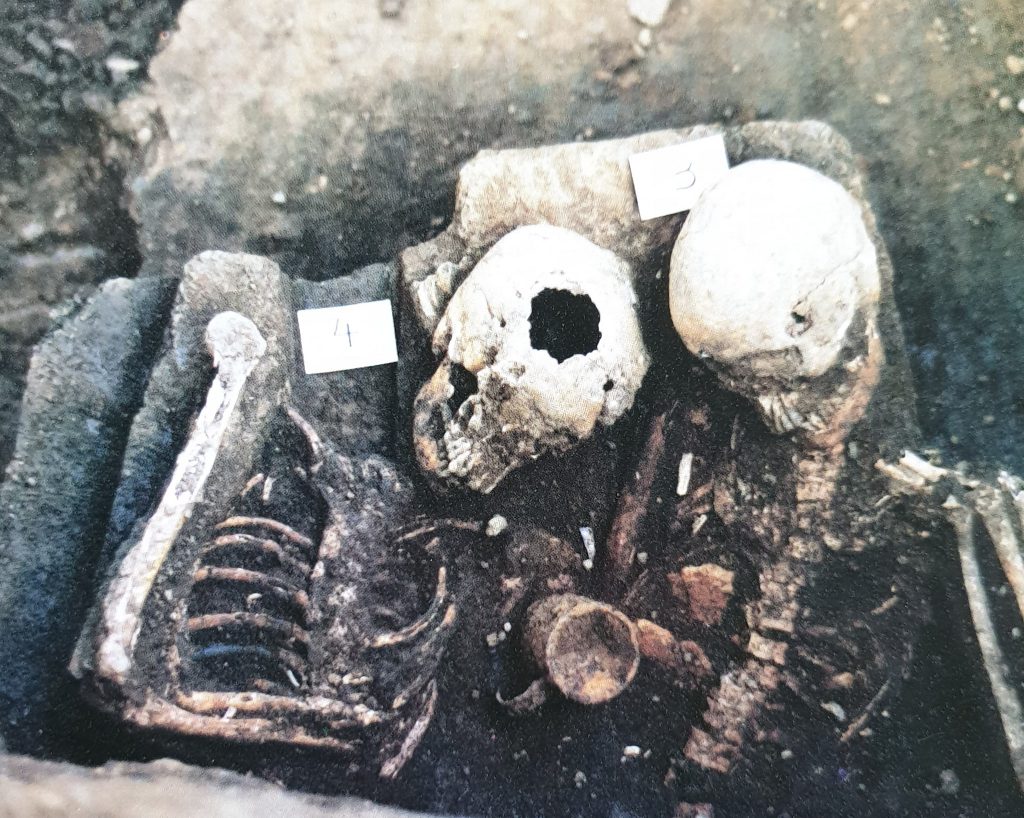
Part 3: Controversy over WW2-era skeletal finds
This story is even more bizarre: I have an undated copy of a LONDON MAIL article – thought to be mid-1990s. It relates that a local jeweler who is linked to the recently opened JEATH #2 museum near the Bridge is purported to have on display skeletal remains that are seemingly linked to Australian POWs who worked the TBR.
Stories as reported in the mass media:
https://apnews.com/article/6b6705c534f10135b6890a0ef4d3b62b
https://www.tampabay.com/archive/1990/11/19/mass-grave-found-near-kwai-bridge/
https://www.latimes.com/archives/la-xpm-1990-11-19-mn-3584-story.html
I am in the midst of searching for any and all information on this topic. One part of the story is told here in Thai:
But Thai journalism is not known for hard-hitting investigative reports, so this is a fluff-piece!
